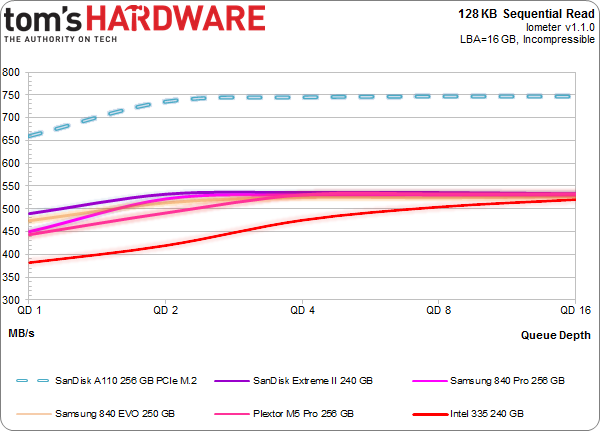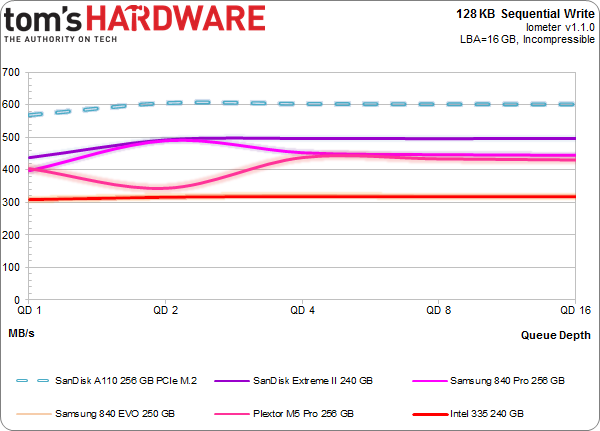SanDisk A110 PCIe SSD: Armed With The New M.2 Edge Connector
We got our hands on an early sample of SanDisk's A110 SSD. So what? Big deal? Not a chance. This thing is PCI Express-attached and sports the new M.2 edge connector. Read on to learn more about the next generation of solid-state storage connectivity.
Results: Sequential Performance
Fantastic sequential read and write performance is a trademark of modern SSDs. To measure it, we use incompressible data over a 16 GB LBA space, then test at queue depths from one to 16. We're reporting these numbers in binary (where 1 KB equals 1024) instead of decimal numbers (where 1 KB is 1000 bytes). When necessary, we're also limiting the scale of the chart to enhance readability.
128 KB Sequential Read
Really, this is where SanDisk's A110 kicks things into high gear. Perhaps I'm giving away the plot a little early, but in most regards, SanDisk's upcoming drive is comparable to the SATA-based SSDs we know so well. That is, except when it comes to sequential performance. The SATA 6Gb/s contenders max out right above 500 MB/s, while the A110 hits its afterburners and flies right by (up to a blazing 750 MB/s). In truth, it's probable that many existing SSDs would do the same if it wasn't for SATA's pesky 6 Gb/s ceiling.
128 KB Sequential Write
We see the story being told in our sequential write performance metric. With the throughput of two PCI Express 2.0 lanes available to it, the A110 pushes past 600 MB/s. Marvell's controller is clearly able to exceed the previously-imposed 6 Gb/s limit, though lower-capacity drives likely won't be able to repeat the performance of this 256 GB sample, since write speed is affected by the number of physical NAND devices present.
Here's a break-down of the maximum observed 128 KB sequential read and write performance with Iometer:
It's not surprising to see SanDisk's A110 at the head of the pack. Is it fair to even include the A110? Absolutely. We're looking at the next-generation storage form factor, after all. There's something else all of these drives share in common: they all leverage AHCI, which, ironically, isn't optimized for solid-state storage. This interface allowed hard drives to asynchronously stack I/O requests for better performance. The benefit over IDE was clear, but there's still a lot more than can be done with SSDs. That'll change with NVMe.
Get Tom's Hardware's best news and in-depth reviews, straight to your inbox.
Technically, the P320h we reviewed in Micron RealSSD P320h Review: A PCIe Drive Capable Of 3.2 GB/s uses IDT's 32-channel PCIe NVMe-capable controller over an eight-lane PCI Express 2.0 interface. Micron uses its own proprietary driver though, meaning it isn't really NVMe. In a real NVMe-enabled ecosystem, you won't need a special driver package. When the time comes, NVMe will help facilitate tremendous performance improvements through a re-imagining of the way I/O is handled by the operating system.
Current page: Results: Sequential Performance
Prev Page More On M.2 And SanDisk's Fancy PCIe Adapter Card Next Page Results: Random Performance-
Mike Friesen Awesome new stuff. Can't wait to see if this drive actually uses the full potential of the M2, and if Samsung or OCZ can one-up them.Reply -
cryan Reply11487924 said:Awesome new stuff. Can't wait to see if this drive actually uses the full potential of the M2, and if Samsung or OCZ can one-up them.
Samsung actually has some pretty awesome M.2 PCIe action going on. We're trying to get our hands on everything, so stay tuned.
Regards,
Christopher Ryan
-
It will be nice to see vendors implement the NVMe connectors in the desktop mobo's, which in turn will redefine case design, as less storage space will be required for storage. I am aware that the initial intent is to direct these at the mobile market, but desktops can benefit as well.Reply
-
cryan Reply11488018 said:It will be nice to see vendors implement the NVMe connectors in the desktop mobo's, which in turn will redefine case design, as less storage space will be required for storage. I am aware that the initial intent is to direct these at the mobile market, but desktops can benefit as well.
You'll really see NVMe take off on the desktop with the move towards SATA Express. A SSD on SATA Express will leverage NVMe and two PCIe Gen 3 lanes. Though some motherboards will (and already do) have M.2 connectors, M.2 really makes more sense in mobile applications. M.2 will only get traction on the desktop insofar as it will begin to replace mSATA. Tons of mainboards, especially smaller form factor products embrace mSATA, and moving to M.2 is a natural transition. However, M.2 drives are hard to find right now, and we really won't see a plethora of options until next year.
Regards,
Christopher Ryan
-
nekromobo I got M.2 toshiba ssd in my Sony Vaio Pro 13.. review that?Reply
and it should have samsung M.2 in some countries.. -
CaedenV I may no longer have motivation to upgrade my system based on CPU specs, but with DDR4, M.2, new restive storage based SSDs, and better chipset features I will still have enough reason to upgrade in a year or two.Reply -
jimmysmitty Reply11488122 said:11488018 said:It will be nice to see vendors implement the NVMe connectors in the desktop mobo's, which in turn will redefine case design, as less storage space will be required for storage. I am aware that the initial intent is to direct these at the mobile market, but desktops can benefit as well.
You'll really see NVMe take off on the desktop with the move towards SATA Express. A SSD on SATA Express will leverage NVMe and two PCIe Gen 3 lanes. Though some motherboards will (and already do) have M.2 connectors, M.2 really makes more sense in mobile applications. M.2 will only get traction on the desktop insofar as it will begin to replace mSATA. Tons of mainboards, especially smaller form factor products embrace mSATA, and moving to M.2 is a natural transition. However, M.2 drives are hard to find right now, and we really won't see a plethora of options until next year.
Regards,
Christopher Ryan
That's what I was thinking. SATA Express is going to be fast enough for now as I have used PCIe SSDs before (OCZ Revo based drive) and compared to my 520 its hard to notice a difference, especially since there are other bottlenecks stopping it from being able to utilize that bandwidth.
This will be great for ultra portable systems though and ITX systems.
-
cryan Reply11488367 said:I got M.2 toshiba ssd in my Sony Vaio Pro 13.. review that?
and it should have samsung M.2 in some countries..
Absolutely... just send it my way and consider it done.
Regards,
Christopher Ryan
-
mikeangs2004 will there be RAID or SLI/CFX for PCIe based SSD's?Reply
I don't think so b/c it's already way above 6G limit.


